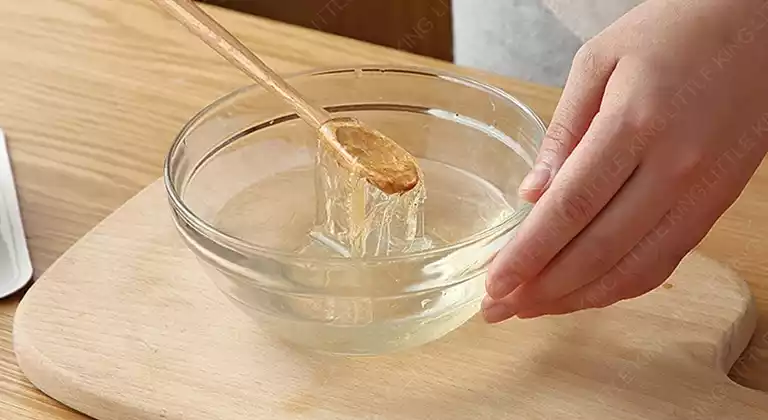Gelatin is insoluble in cold water, but soluble in hot water. Pour the dry edible gelatin into food directly will lead to insufficient dissolution and weakened function.

How to make gelatin solution before cooking?
Method 1: Soak gelatin powder or granule in cold water for 5-10 minutes, until it swells completely. Water is about 5-10 times the weight of gelatin. Then put it into hot water, and stir slowly until it dissolves.
Method 2: Add the it directly into the hot water and agitate gently until it is completely dissolved.
Method 3: Soak leaf gelatin in cold water for 5-10 minutes until it becomes soft. If there are many sheets, try your best to avoid overlapping, otherwise the gelatin sheets in the middle will not be hydrated sufficiently. Finally, dissolve it in hot water or heat with watery food directly.
Method 4: If it is instant gelatin, put it directly into cold water and stir until it is all dissolved.
Hints for leaf gelatin, gelatin powder and granule
It is important to develop good habits. Water should not be poured into powder directly, otherwise the swollen powder will turn into lumps (its surface absorbs water and expands, while the interior remains in a powdery state). Although it will eventually absorb water completely, it takes extra time. One way to avoid it is to mix the gelatin with other media, such as sugar powder. Then sprinkle the mixture into water slowly. It's not reasonable to reverse the order (pour water into the powder).
Gelatin is a whipping agent, so vigorous agitation will produce too many air bubbles and eventually reduce food quality. The prepared gelatin solution should be temporarily stored in a hot water bath to stop its gelation. Bacteria can easily grow in this solution, so it is important to make sure your workplace is clean. Because it is difficult to preserve, estimate the amount of gelatin to be used and try not to make excess solution.
Gelatin is prone to decomposed by heat and acid. To minimize the time it reacts with acid at high temperature, organic acid is added near the end of cooking. For example, during gummy candy making, it is added after organic acid and the temperature of syrup should preferably not exceed 80℃. They are quickly stirred and then immediately placed in starch molds to cool. You can also increase gelatin used to offset the loss of Bloom value and viscosity.
The strength of jelly is also related to its thermal history. If the ambient temperature is much lower than gelling point, it will lead to a quick gelation and reduce its strength. When it cools down and solidifies slowly, a stronger jelly is obtained. A solid jelly usually forms within a few hours. Its hardness and elasticity increase during the following days.
Some fruits are nightmare of gelatin, because they have enzymes that break down protein. It is important to boil raw pineapple or raw papaya to destroy the enzymes before mixing them with gelatin solution.